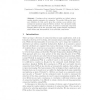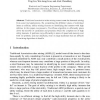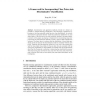107
Voted
PAKDD
2005
ACM
15 years 6 months ago
2005
ACM
The availability of microarray data has enabled several studies on the application of aggregated classifiers for molecular classification. We present a combination of classifier ag...
142
Voted
PAKDD
2005
ACM
15 years 6 months ago
2005
ACM
Mixture models, such as Gaussian Mixture Model, have been widely used in many applications for modeling data. Gaussian mixture model (GMM) assumes that data points are generated fr...
102
Voted
PAKDD
2005
ACM
15 years 6 months ago
2005
ACM
Abstract. It is estimated that 20% of genes in the human genome encode for integral membrane proteins (IMPs) and some estimates are much higher. IMPs control a broad range of event...
PAKDD
2005
ACM
15 years 6 months ago
2005
ACM
Covariances from categorical variables are defined using a regular simplex expression for categories. The method follows the variance definition by Gini, and it gives the covaria...
104
click to vote
PAKDD
2005
ACM
15 years 6 months ago
2005
ACM
We study the problem of mining frequent value sets from a large sensor network. We discuss how sensor stream data could be represented that facilitates efficient online mining and ...
100
Voted
PAKDD
2005
ACM
15 years 6 months ago
2005
ACM
Traditional association rules mining cannot meet the demands arising from some real applications. By considering the different values of individual items as utilities, utility mini...
PAKDD
2005
ACM
15 years 6 months ago
2005
ACM
Self-training is a semi-supervised learning algorithm in which a learner keeps on labeling unlabeled examples and retraining itself on an enlarged labeled training set. Since the s...
119
Voted
PAKDD
2005
ACM
15 years 6 months ago
2005
ACM
Abstract. Discriminative and generative methods provide two distinct approaches to machine learning classification. One advantage of generative approaches is that they naturally mo...
103
Voted
PAKDD
2005
ACM
15 years 6 months ago
2005
ACM
This paper presents the advances in subgroup discovery and the ways to use subgroup discovery to generate actionable knowledge for decision support. Actionable knowledge is explici...
80
Voted
PAKDD
2005
ACM
15 years 6 months ago
2005
ACM
In many modern application ranges high-dimensional feature vectors are used to model complex real-world objects. Often these objects reside on different local sites. In this paper,...



